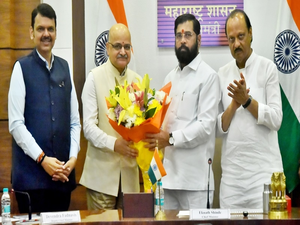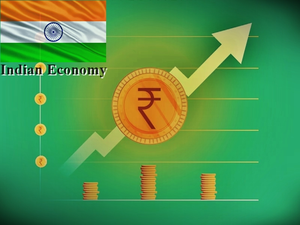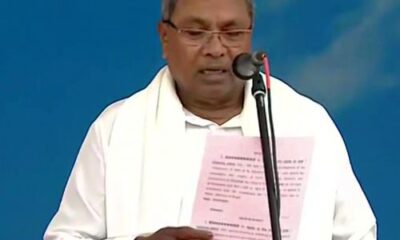Businesses
Gautam Adani lists 3 key areas in building robust national infrastructure
Mumbai, June 19 (IANS) Gautam Adani, the Chairman of the Adani Group, on Wednesday, listed three key areas which will further help the national infrastructure grow in years to come, driving the country to realise its goal of becoming a $30 trillion economy by 2050.
According to Gautam Adani, touted as ‘The Infra Man of India,’ the three key areas are — the role of government policies and governance in building infrastructure; the future of infrastructure and its interconnection with sustainability; and Adani Group’s areas of focus and the role it is playing in developing national infrastructure.
The 1991 economic liberalisation and reforms, announced by the late Prime Minister PV Narasimha Rao and the finance minister at that time, Dr Manmohan Singh, marked a watershed moment in India’s economic history and dismantled the ‘Licence Raj’ which had seen the government involved in almost every approval that businesses needed.
The statistics tell the story. As per World Bank data: In the three decades prior to liberalization, the Indian GDP grew by 7 times. And in the three decades post-liberalisation, our GDP grew by 14 times.
“There could be no better validation than these numbers on the power of liberalisation,” Gautam Adani said while delivering the keynote at the Crisil Ratings’ ‘Annual Infrastructure Summit’.
However, the liberalisation in 1991 marked a major turning point. The breaking down of the ‘Licence Raj’ meant that the government did away with industrial licensing for most sectors.
It eliminated much of the requirement for businesses to obtain government permission to invest, or set prices, or build capacity.
“If the period between 1991 and 2014 was about putting down the foundations and building the runway, the period from 2014 to 2024 has been about the aircraft taking off,” Gautam Adani noted.
And a strong example of this ‘take off’ is the National Infrastructure Pipeline, the NIP programme.
The core essence of the NIP is its integrated approach involving participation from both the public and private sectors with the funding model divided between the two.
“I consider the NIP programme that has earmarked a projected investment of Rs 111 lakh crore over the period FY20-25 as a benchmark of how a government can put in place a national view of over 9,000 infrastructure projects across sectors like energy, logistics, water, airports and social infrastructure,” the Adani Group Chairman added.
The single most important catalyst enabling this take-off has been the quality of ‘governance’ that we have witnessed over the past decade, and the metrics speak for themselves.
“India’s fiscal investment has doubled, from 1.6 per cent of GDP to 3.3 per cent of GDP. Corporate Income Tax rates have fallen from 30 per cent to 22 per cent, creating headroom for corporates to invest. And the current account deficit fell from 3.5 per cent of GDP to 0.8 per cent of GDP,” informed Gautam Adani.
These outcomes are fundamentally rooted in this government’s effectiveness in institutionalising policy for transforming our nation’s landscape from one of challenges to one of possibilities.
The results are visible to all.
“First, almost every foreign visitor that I meet these days talks about the extraordinary infrastructure growth they see in India be it the quality of the multi-lane highways, the massive construction projects all over the country, access to ports across the nation’s coastline, the rapid penetration of green energy, a world-class and modern transmission grid, dedicated freight corridors, the quality and access to airports across the country, several new Metro rail networks, and the massive trans-sea links,” according to Gautam Adani.
Second, the Indian government’s Aadhaar and UPI infrastructure has transformed the financial ecosystem in the country.
This system has democratised access to financial services to such an extreme level that it has allowed even the previously unbanked population to participate in the digital economy.
“This has led to the stronger tax collections that we have already started to witness. It has also spurred the growth of fintech companies, streamlined subsidy distribution, and enhanced transparency, contributing significantly to the country’s digital transformation and economic growth,” Gautam Adani emphasised.
And third, is the very visible aspect about the ‘young-ness’ of India that we formally call the ‘demographic dividend’.
India’s median age stands at less than 29 years, while China’s median age today is already at 39.
“What is more remarkable is that even in 2050, India’s median age will be just 39 years. This means that India will be at its peak consumption for at least the next three to four decades. No other nation will have this scale advantage of domestic demand,” said Gautam Adani.
In terms of numbers, estimates show that by the end of FY32, the year India has targeted to become a 10 trillion-dollar economy, the cumulative spend on infrastructure will exceed 2.5 trillion dollars.
“These are all indicative of the potential of India, and I can confidently state that the platform to create totally new market spaces in India is now in place,” said Gautam Adani.
The Adani Group Chairman also spoke about two emerging sectors: infrastructure to enable energy transition and digital infrastructure.
“Let me first expand on the energy transition space. This will fundamentally change the global energy landscape forever. The global transition market was valued at approximately 3 trillion dollars in 2023 and is expected to grow to nearly 6 trillion dollars by 2030, and thereafter double every 10 years till 2050,” informed Gautam Adani.
India aims to install 500 gigawatts of renewable energy capacity by 2030.
“This ambitious target will require annual investments of over 150 billion dollars. The transition to green energy in India is expected to generate millions of new jobs in sectors such as solar and wind, energy storage, hydrogen and its derivatives, EV charging stations, as well as grid infrastructure development,” Gautam Adani stated.
On the ‘digital infrastructure’ space, Gautam Adani said we have now arrived at a world where the AI revolution sits at the core of every digital initiative.
“And at the heart of all this action is the Data Centre, the critical infrastructure needed to power all forms of computational needs, especially AI workloads for machine learning algorithms, natural language processing, computer vision and deep learning”.
“The fact is that the infrastructure required for energy transition and the infrastructure required for digital transformation are now inseparable as the technology sector becomes the largest consumer of the precious green electrons,” Gautam Adani added.
Over the past 30 years, the Adani Group has leveraged these drivers to become the world’s second-largest solar power company; India’s largest airport operator with 25 per cent of passenger traffic and 40 per cent of air cargo; India’s largest Ports & Logistics company with 30 per cent of national market share; India’s largest integrated energy player spanning across generation, transmission & distribution, LNG and LPG terminals, and city gas and piped gas distribution; India’s second largest cement manufacturer; and several other new sectors including metals, petrochemicals, aerospace and defence, super apps, and industrial clouds.
“Nothing holds more potential than the two I have outlined — the energy transition space and the digital infrastructure space. This is why the Adani Group is making massive investments in both these areas,” said Gautam Adani.
“The next decade will see us invest more than $100 billion in the energy transition space and further expand our integrated renewable energy value chain that today already spans the manufacturing of every major component required for green energy generation,” the Adani Group Chairman added.
–IANS
na/uk
Businesses
Investors’ wealth eroded by a massive Rs 9.19 lakh crore

Investors’ wealth eroded by a massive Rs 9.19 lakh crore on Tuesday as markets came under heavy sell-off with the BSE benchmark index Sensex falling 930.55 points.
Extending its previous day’s decline, the BSE Sensex plummeted 930.55 points or 1.15 per cent to settle at 80,220.72. During the day, it tanked 1,001.74 points or 1.23 per cent to 80,149.53.
The market capitalisation of BSE-listed firms eroded by Rs 9,19,374.52 crore to Rs 4,44,45,649.22 crore (USD 5.29 trillion). “There has been no respite from FIIs selling in local equities in the current month so far, which has been creating uncertainty among domestic investors.
Also, foreign investors are fleeing Indian equities to invest in relatively cheaper locations such as China, especially after the stimulus announcement by its government to boost its slowing economy.
“Along with sectoral stocks, mid and smallcap stocks too bore the brunt as persistent buying had led to valuations in several stocks getting expensive and hence the breather,” Prashanth Tapse, Senior VP (Research) at Mehta Equities Ltd, said.
From the 30 Sensex pack, Mahindra & Mahindra, State Bank of India, Power Grid, Tata Steel, IndusInd Bank, Tata Motors, Larsen & Toubro, NTPC, Bajaj Finance and Reliance were among the biggest laggards. In contrast, ICICI Bank, Nestle and Infosys were the gainers from the pack.
Businesses
NITI Aayog shares a $300 billion economy roadmap for Mumbai Metropolitan Region

Mumbai, Aug 22 (IANS) The NITI Aayog in its presentation to the Maharashtra government on Thursday suggested a roadmap for the Mumbai Metropolitan Region (MMR) to become a $300 billion economy by 2030 from the present $140 billion.
NITI Aayog CEO BVR Subrahmanyam during his meeting with Maharashtra Chief Minister Eknath Shinde and Deputy CMs Devendra Fadnavis and Ajit Pawar, suggested that the state can achieve this ambitious target with the promotion of MMR as global services’ hub, affordable housing and slum rehabilitation, tourism, port-proximate integrated manufacturing and logistics hub, planned urbanisation and intensive transport oriented development, sustainability projects and world-class urban infrastructure and transport.
NITI Aayog has said that the state government can attract a private investment of $125-135 billion, incremental GDP growth of $130-150 billion and additional capital by the state government of the order of Rs 50,000 crore over 5-6 years to chase the goal of making MMR a $300 billion economy.
“MMR is a $140 billion economy across 5 districts and covering 9 municipal corporations with a 25.8 million population and 10 million jobs. Good news is that MMR is on a positive growth trajectory on the back of $50 billion ongoing infrastructure investments. Our vision is to grow MMR into a $300 billion economy by 2030 and $1.5 trillion economy by 2047,” said Subrahmanyam in the presentation.
According to NITI Aayog, MMR has a potential to become a global services hub due to the existing two world-class business districts, Wadala and BKC for financial services and after the development of Navi Mumbai Aerocity as a global aviation city.
It has suggested that the rehabilitation of 2.2 million slums will create new housing stocks in addition to around 1 million affordable housing for low income and middle income group segments.
NITI Aayog has suggested the state can promote two themed tourism development hubs at Gorai and Madh and Alibaug and implement a masterplan for a 300 km coastline.
Further, the MMR can promote port proximate integrated manufacturing and logistic hub with the development of Kharbav integrated logistic cluster as a multi-modal logistic park, circular economy parks and electronic manufacturing and manufacturing cluster for white goods assembly at Khalapur-Panvel section.
In the wake of the development of Rs 76,000 crore Vadhavan port, NITI Aayog has suggested that it can be exploited for the promotion of green hydrogen, steel, chemicals, integrated textiles and apparels.
Further, the NITI Aayog has suggested that the government should release a slew of policies for services, tourism, affordable housing, and transport-oriented development. In addition, the government will have to craft investment promotion and land allocation policy, simplified and enabling urban planning policies, women-inclusivity blueprint and Green MMR policy.
Chief Minister Eknath Shinde has said that the government is focusing on the construction of affordable housing, development of a data center in Navi Mumbai, and completion of Alibaug Multimodal Corridor. Recently, the state government has cleared projects with an investment of Rs 80,000 crore. The government has stepped up efforts to promote tourism along the 720 km coastline.
(Sanjay Jog can be contacted at sanjay.j@ians.in)
–IANS
sj/pgh
Businesses
Finance Ministry sees food inflation easing further on back of better monsoon

New Delhi, Aug 22 (IANS) Inflationary pressures in the Indian economy eased in July and food inflation is expected to come down further with this year’s better monsoon leading to higher agricultural production, according to the Finance Ministry’s monthly review released on Thursday.
Retail inflation based on the Consumer Price Index eased from 5.1 per cent in June 2024 to 3.5 per cent in July 2024, the lowest since September 2019.
This was mainly due to a significant fall in food inflation. It declined to 5.4 per cent in July 2024 from 9.4 per cent in June 2024, the review states.
The substantial fall witnessed in food inflation was helped majorly by a decline in vegetable inflation from 29.3 per cent in June 2024 to 6.8 per cent in July 2024 and mild deflation in ‘oils and fats’ and spices.
On the other hand, core inflation (which excludes food and fuel) was at a moderate level of 3.3 per cent in July 2024.
Overall, the retail inflation rate moderated to 4.6 per cent in the first four months of FY25 as compared to 5.3 per cent in FY24 (April-July), according to the review.
With moderate core inflation and positive progress in the monsoon, the headline inflation outlook is positive. Assuming a normal monsoon, CPI inflation for FY25 is projected at 4.5 per cent by the RBI, with Q2 inflation at 4.4 per cent.
A steady progress in the southwest monsoon has supported agricultural activity. The cumulative southwest monsoon rainfall was 3 per cent higher than the long-period average up to August 19, 2024. Further, the spatial distribution has improved, with 84 per cent of subdivisions receiving normal or excess rainfall. This has enabled healthy Kharif sowing.
As of August 16, the actual sowing area under total foodgrains was 4.8 per cent higher than the corresponding period of the previous year, while progress in cereals and pulses was 4.6 per cent and 5.7 per cent higher than the previous year.
Corresponding to healthy progress in monsoon, availability of water level in reservoirs improving, ensuring water adequacy for irrigation during current Kharif and upcoming rabi crop production. The storage availability in 150 reservoirs as of August 15, was 111 per cent of the corresponding period of last year and 114 per cent of the average storage of the last ten years, according to the Central Water Commission. This augurs well for healthy food production that will aid in cooling food inflation in the upcoming months. Further, to enhance productivity and resilience in the agriculture sector, various measures have been announced in the Union Budget FY25, the Finance Ministry said.
–IANS
sps/vd
Businesses
Indian economy is on upswing: Finance Ministry

New Delhi, Aug 22 (IANS) The Indian economy experienced a notable upswing across various economic indicators in July 2024, signalling strong and resilient business activities with both the manufacturing and services sectors posting a robust performance, according to the Finance Ministry’s monthly review released on Thursday.
“The month saw impressive milestones being reached, substantial growth in GST collections, and a significant rise in e-way bill generation, which points to an overall increase in economic activity. The stock market indices also reached record highs in July,” the review states.
On balance, India’s economic momentum remains intact. Despite a somewhat erratic monsoon, reservoirs have been replenished. Manufacturing and services sectors are expanding, going by the Purchasing Managers’ indices. Tax collections – especially indirect taxes, which reflect transactions – are growing healthily, and so is bank credit, according to the review.
Inflation is moderating, and exports of both goods and services are doing better than they did last year. Stock markets are holding on to their levels. Foreign direct investment is looking up as gross inflows are rising, the review states.
Gross GST collections for July 2024 maintained their momentum, achieving their second-highest level since May 2023. The total gross GST revenue rose by 10.3 per cent year-on-year (YoY), bringing the total for FY 25 (April to July) to Rs 7.4 lakh crore.
This increase in GST collections also highlights robust compliance and expansion of GST coverage across various economic activities.
The upward level shift is reflected in the average monthly GST collections rising from Rs 1.68 lakh crore in FY24 to Rs 1.85 lakh crore in FY25.
The year-on-year increase in e-way bills reached a nine-month peak of 19.2 per cent with the total number of e-way bills issued in July surging to 10.5 crore, setting a new single-month record.
According to the review, the manufacturing sector has continued to demonstrate robust performance in the first four months of FY25, as evidenced by the strong performance of various high-frequency indicators.
The Purchasing Managers’ Index (PMI) Manufacturing, a crucial gauge of the economic vitality of the manufacturing sector, stood at 58.1 in July 2024, significantly above the series long-run average and among the highest recorded in recent years. This expansion, driven by buoyant demand conditions and a surge in production volumes, bodes well for the overall health of the economy.
Similarly, the service sector continued to perform well.
PMI services remained in an expansionary zone at 60.3 in July 2024, driven by expansion in international sales, an increase in new order uptakes, and a rise in new export orders.
Despite a rise in wages and material costs which pushed up business expenses, overall sentiment in the services sector remains upbeat, driven, among others, by an upswing in the tourism cum hotel industry induced by leisure travel, business travel, and social events, the Finance Ministry said.
–IANS
sps/pgh
Businesses
Sensex closes 147 pts up 81,053, Nifty above 24,800

Mumbai, Aug 22 (IANS) Indian stock markets again closed higher on Thursday due to positive sentiment in the markets.
At closing, Sensex was up 147 points, or 0.18 per cent, at 81,053 and Nifty was up 41 points or 0.17 per cent at 24,811.
The market’s positive sentiment was bolstered by optimistic global cues, particularly from the US markets, where the S&P 500 extended its winning streak, reflecting investor confidence amid expectations of potential interest rate cuts by the Federal Reserve.
During the day, Sensex traded in the range of 80,954 to 81,236 and Nifty traded in the range of 24,784 to 24,867.
In the Sensex pack, Bharti Airtel, Tata Steel, ICICI Bank, Titan, Asian Paints, UltraTech Cement, JSW Steel, Maruti Suzuki and SBI were the top gainers. Tata Motors, M&M, Wipro, NTPC, TCS, Power Grid, Sun Pharma, Axis Bank, and Nestle are the top losers.
Thursday’s market rally was led by Nifty Bank which settled up 300 points or 0.59 per cent at 50,985.
Among the sectoral indices, PSU Bank, fin service, FMCG, metal, realty and Private bank were the major gainers. Pharma, IT and energy were the major laggards.
An upward trend was also seen in small and medium stocks in the trading session. The Nifty midcap 100 index was up 400 points or 0.69 per cent at 58,844 and the Nifty smallcap 100 index was at 19,099, up 32 points or 0.17 per cent.
According to market experts, the domestic market witnessed modest gains owing to positive global sentiments.
“Particularly, the recent signs of weakness in the US non-farm payroll data have strengthened the case for potential interest rate cuts in September. However, in the broader market, investors are being cautious, opting for a selective approach, awaiting more clarity from central bank leaders in Japan and the US,” they added.
–IANS
avs/vd
-
Video2 years ago
PM Modi Attacks Congress in Karnataka with “Kerala Story”
-
Politics2 years ago
Siddaramaiah & DK Shivakumar sworn in as Chief Minister & Deputy CM respectively
-
Cricket2 years ago
CSK players rejoice 5th IPL title with their families (Pics)
-
Entertainment2 years ago
Karan Deol weds his longtime Girlfriend Drisha Acharya (Pics)
-
Sports7 years ago
History Of Official FIFA WORLD CUP Match balls
-
India2 years ago
Ashwini Vaishnaw: Railway Board recommends CBI probe in the Odisha railway disaster
-
Entertainment2 years ago
Urvashi Rautela dazzles on Cannes 2023 red carpet (Pics)
-
Entertainment2 years ago
Sunny Leone gets ready for Kennedy premiere in Cannes (Pics)































